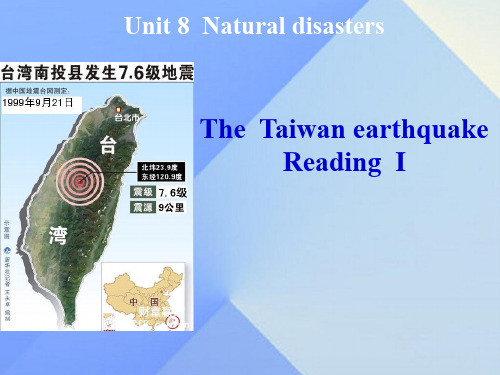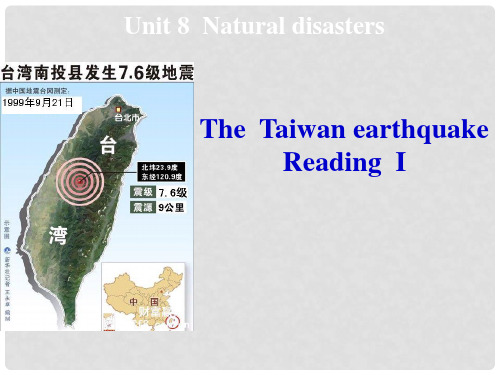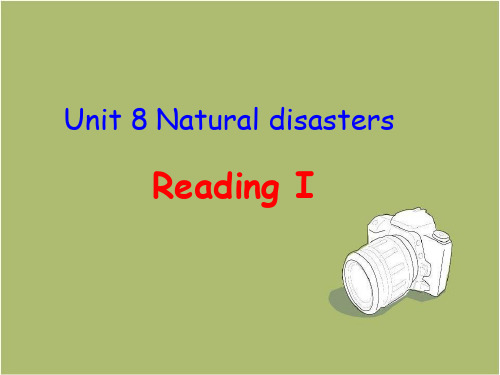8A Unit8 Natural Disasters Reading (共15张PPT)
- 格式:ppt
- 大小:3.15 MB
- 文档页数:16






8A Unit8 Natural disasters 教案第一课时Welcome to the unitTeaching aims:To introduce the topic of disaters.To identify vocabulary related to disasters.To identify weather conditions and label pictures with correct words.Focus and difficulties: To recognize the weather conditions and natural disaster.Teaching methods:Communication and descriptionTeacing aids:recorder Multi-media computerTeaching procedures:Step1 Lead in :T: What’s the weather like today?Ss: It …Revise some other words about weather.e.g. rain, snow, wind.…Step2 Presentation1.Show some pictures of snowstorm that happened inChina during last Spring Festival .Get them to answer the questions about it.﹙1﹚.Do you like snow in winter?﹙2﹚.Do you think too much snow is good or bad for people?2.Encourage students to tell their ideas.Show more pictures of bad weather.Ask: What caused the trouble or problems?Help students to answer : nature. They are natural disasters.They cause the bad weather .They make people get into the trouble.Step3 Practice1.T: Do you know what other natural disasters ? What words do we use to talk about bad weather ?Elicit from students other bad weather conditions. ( rainstorm, snow storm,typhoon.e.g.)ers with the class as a whole,then read together.Teach some new words.Step4 ActivityDivide the students into groups of four to discuss. Bring some photos to each group and ask students to write a headline about natural disasters or accidents.Step5 Presentation1.T: Look at the pictures ,people suffered from these natural disasters . What can we do to help them.Students will discuss it warmly. Then teacher leads students to the comic strip.2.T:Hobo has some trouble. What happened to him? Let’s have a look. Students look at the pictures. Teacher asks some open questions about each 2. Play the tape and students read after it.Explain some language points.Step 5.gamesAsk students to role-play the conversation.Step 6.Homework:Revises the contents we have learned.Preview Reading8A Unit8 Natural disastersReading(1)Teaching aims:1.To infer the meaning from the key words,pictures and the context.2.To elicit any information about the earthquakes in Taiwan or in other parts of the world.3.To develop the Ss’ability and skills reading comprehensioand let the Ss learn how to describe natural disastersDifficult points: The key words and phrasesthecomprehension of the story. Teaching methods: reading and talkingTeacing aids: recorder Multi-media computerTeaching procedures:Step1 Lead in :T: we have learnt some natural disastrs last time .What disasters have we leart?Encourage students to say something about the natural disasters.Show some picturs of an earthquake that happened in Wengchuan,sichuan on May12,2008 .Step4 Reading and answering1. Listen and read after the tape one paragraph by one paragraph.Check if they understand by asking more questions about the passage.2.Invite the students to read the whole passage in front of the class.Encourage them to mime and gesture in order to illustrate the different aspects of the experience.Step5. Practice1.Ask stuednts to read the sentences in the boxes in PartC and fill in the blanks. Check the answers with the whole class.2.Divide the students into groups of four.Retell the story ,then encourage some of them to retell in front of the class.Homework1.Recite the new words .2.Try to read the story as fluently as you can8A Unit8 Natural disastersReading(2)Teaching aims:1.To scan the passage.2.To explain some difficult and important language points and to use them.3.To make an interview about the earthquake.Difficult points:some language structuresTeaching methods: reading and talkingTeacing aids:recorder Multi-media computerTeaching procedures:Step1 revision1.Revise the names of natural disasters.2.Show the students the photos of the story of Taiwan earthquake and help them to retell it.Step2 ScanningScan each paragraph and encourage the students to tell their difficulties.Teacher helps students to solve them. Teacher explains language points to students.Step3 Activity1.Work in pairs . One acts as a reporter. The other acts as Timmy. Give some questions to help them.After that ask who he/she thinks is the best news reporter. Step4 DiscussionWhat can you do when you are in the earthquake ?What will you do when the others are in danger ?Homework1. Try to retell the story .2. Try to learn the useful words and sentences.8A Unit8 Natural disastersVocabularyTeaching aims:1. Students learn how to change nouns to adjectives.2. Learn to use the words and phrases to describe weather conditions.3. Get the students to use vocabulary to make a weather forecast. Teaching Aids:Multi-media computerDifficult points:To use the words and phrases to describe weather co nditioTeacing aids:Multi-media computerTeaching procedures:Step1 RevisionHelp students to revise Reading.Step2 Presentation1. Revise the name of natural disasters,and say‘many natural disasters arecaused by bad weather. Let’s talk about the weather.’2.Teach the new words by showing pictures.3.Ask students to finish PartA quickly and read aloud these words .Step3 Practice1. Get the students to find out the rule of changing the nouns into adjectives.2.Games. Ask students to draw pitures of different weather ,Students take turns to show the pictures ,the rest of the class say the noun and adjective describing the pictures.3.Elicit from students as many different as weather conditions as possible.4.Get some pairs to make up the dialogue.(What kind of weather do you like/dislike? Why?)Step4Presentation1.Talk about the weather forecast.2.Finish the dialogue in the book and check the answers.3.Look at the weather map and talk about the weather in China. Homework1.Try to rember the words about the weather .2.To make a Liyang’s weather forecas .8A Unit 8 Natural disasters GrammarTeaching Objectives:To learn more about the past continuous tense.To use the tense to talk about things.Teaching contents:Words: discuss, terrible, break, snowball, snowman, hitPhrases: search the Internet discuss…with… plan a trip to Tangshan on the side of the road drive you to school as usual break downSome others: project guidebook a terrible snowstormTeaching preparations:Tape recorderComputer PicturesTeaching procedures:Step1 Revision1.Check the homework and test the students about the new words and phrases that welearnt last lesson. Ask the students to work in pairs; one gives nouns that relate to the weather and then the other gives the adjectives quickly.2.Talk to the students about the bad weathers that can cause natural disasters.Step2 PresentationT:Here is an article, can you find out how many tenses are there in this article?Today is fine, the sun is shining brightly and it is a beautiful sunny day. I always get to school at 7 o’clock everyday, but I was late today because I couldn’t find the key to my bike. I think I will take a taxi to go home tonight.(let the students think of the simple present tense, simple past tense, present continuous tense and simple future tense, write down the rules)Compare the present continuous tense with the past continuous tense for the Ss, let them find out the differences. Then tell them when to use the past continuous tense.Step3 Practice (game time)T: Today we’ll learn the past continuous tense. First can you help me to find my key? The taxi is so expensive and I really want to enjoy the pretty day on my bike. I might leave my key somewhere and maybe someone took my key away. You can ask me questions toT: I was having dinner at 6:30p.m. last night. What was my father doing at that time?Do it for several times with the children and then let them try to make up sentences with the information in the timetable.What was our teach er doing…?What was her father/ her mother/ her little dog doing from… to…?(let the students ask these questions to practice the past continuous tense)Then the teacher asks:Was I having a shower at 6:00p.m.?Teach them: Yes, I was. No, I wasn’t.Yes, you were. No, you weren’t.Show the students the rules again and let them work in pairs.Step 4 Practice1. Let the Ss finish the exercise on page 99 and check the answers.2. T: We know that there are a lot of natural disasters in the world this year, for example, we have a terrible earthquake and a snowstorm in China. It brought a lot of troubles to our daily lives, what were they? (snowball, snowman, break down, fall down)3. Finish the exercise on page 100 and check the answers.4. Do more exercises.5. show the differences between the simple past tense and the past continuous tense. Step 7 HomeworkFinish the Workbook exercises.、8A Unit 8 Natural Disasters Integrated SkillsTeaching Objectives:To learn some useful expressions in case of the emergency call.To train the ability of getting details from the tape and use the information to finish the report form.To retell the accident with the information on the accident report call.Teaching contents:Words: condition cover caller arrival serious victim mobile phone Phrases: weather conditions cover the whole roadTime of arrival get worse Crash into catch fireSend the victim to…Sentences: She is as slim as I am.She is also helpful and is ready to help people any time.Betty wants to be a singer and travel around the world when she grows up.He has poor eyesight because of working on the computer too much at night.His legs are very long and they do not fit under the school desks.She is kind and never says a bad word about anyone.Teaching preparations:ComputerPicturesTape recorderTeaching procedures:Step 1 Warm-upT: What’s the weather like today? How can I know the weather a day earlier? (report)T: Through the weather report we can know the weather conditions. How many kinds of weather do you know? (windy, cloudy, sunny, rainy, snowy) And which do you think is the most interesting one? Why ?Show them the picture and say: The snow covers all the things and we can play with our friends. But if there is too much snow, it will be a disaster, and there will be some accidents on the road.Step 2 PresentationShow a picture about a car accident to the students.T: What can you see in the picture? (crash into). If there are some people in the car, they may hurt. So we call them “victims”. And we have to send them to the hospital, we can call what number?Teach the students some useful phone numbers.Present a picture.T: what information can you get from the picture? (a snowstorm, crash into a tree, trapped in the car, 2 people)T: they are Mr Su and Mrs Su, look at part A2 and fill in the blanks as many as you can. Then listen to the tape and try to complete the accident report form.Step 3 Practice1: listen to the tape and fill in the blanks. Play the tape again and then check the answers.2.listen for the third time and solve some problems that the students have.3.T: suppose that you are an reporter and now you are interviewing the couple, workwith your partner and try to make a dialogue. Here are some questions:What happened to you, Mr Su?Were you alone in the car?Why didn’t you get out by yourself?Step 4 Presentation1. T:Sandy told her e-friend about the snowstorm in her e-mail. Vivien also told her about a natural disaster in her school. Let’s listen to the conversation and find out what disaster it was.2. Play the tape and try to answer these questions:What happened in Britain?What caused the fire?Was anyone hurt?1.read after the tape and let the students themselves make up some dialogues using this asa model.Step 5 Homework8A Unit8 Natural disasterstaskTeaching aims:1. To tell the true information while writing.2. To give the outline of the writing.3. To write an article about the natural disaster.Teaching contents:Four skills:V ocabularies: nearby sandstorm warningPhrases: share….w ith…look out of the window forget to bring my keys Continue to fall around us come from behind fall overWeather report snowstorm warningOthers: Vocabularies: remove signal rollPhrases: the noise of traffic remove the snow typhoon signal number Teaching aids:Multi-media, recorderTeaching steps:Step 1: Presentation:1. Explain the language surrounding to the students, help them to understand the background.2. Divide all the students into 4 groups, read sandy’s notes (P105-A), and ask partners questions about the snowstorm, help the students to know the details of the storm.3. Read the notes together, and discuss about it in groups, the topic is what it is about ( the general speaking of the snowstorm --- before the snowstorm --- after the snowstorm)4. T: when we write an article, we should make a writing plan. One of the good ways to make the good writing plan is to draw a flow chart. Sandy drew a flow chart before writing. Look at the flow chart in part B and find the answer from part A.5. To ask questions with Sandy’s flow chart, and check the answers.Step2: Reading1. Read the article (P106-C), and ask: which part of the flow chart does each paragraph belong to?Para. 1: Introduction.Para 2-3: During the snowstorm.Para 4: After the snowstorm.2. Read the article again, finish part C.3. Let some students read the passage, and checkout.Step3:Writing.1. Work in pairs, think about the earthquake in Wenchuan Sichuan, write down some notes on the notebook, and give the flow chart like pare B, check out for each other, correct them and start writing.2. Encourage the students to get the sketch first and compare it with the flow chart. Find out the mistakes. The teacher can give some useful help, such as some words, phrases, and so on.3. Check the articles and read some of them.Step 4: Homework1. Recite some new words.2. Finish some exercises.。